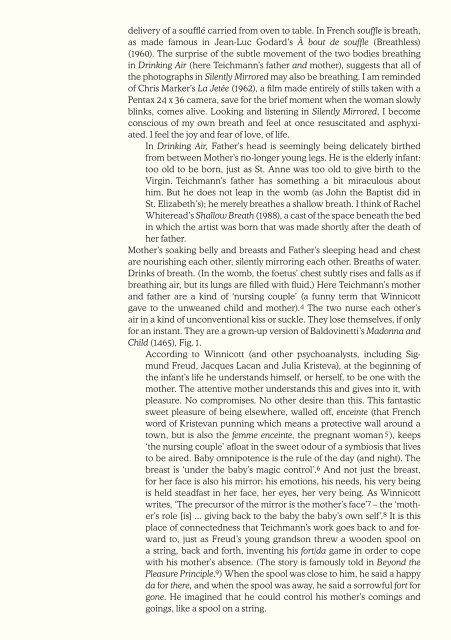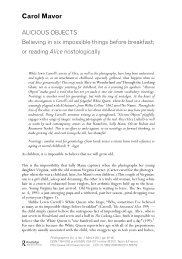View PDF - Esther Teichmann
View PDF - Esther Teichmann
View PDF - Esther Teichmann
Create successful ePaper yourself
Turn your PDF publications into a flip-book with our unique Google optimized e-Paper software.
delivery of a soufflé carried from oven to table. In French souffle is breath,<br />
as made famous in Jean-Luc Godard’s À bout de souffle (Breathless)<br />
(1960). The surprise of the subtle movement of the two bodies breathing<br />
in Drinking Air (here <strong>Teichmann</strong>’s father and mother), suggests that all of<br />
the photographs in Silently Mirrored may also be breathing. I am reminded<br />
of Chris Marker’s La Jetée (1962), a film made entirely of stills taken with a<br />
Pentax 24 x 36 camera, save for the brief moment when the woman slowly<br />
blinks, comes alive. Looking and listening in Silently Mirrored, I become<br />
conscious of my own breath and feel at once resuscitated and asphyxiated.<br />
I feel the joy and fear of love, of life.<br />
In Drinking Air, Father’s head is seemingly being delicately birthed<br />
from between Mother’s no-longer young legs. He is the elderly infant:<br />
too old to be born, just as St. Anne was too old to give birth to the<br />
Virgin. <strong>Teichmann</strong>’s father has something a bit miraculous about<br />
him. But he does not leap in the womb (as John the Baptist did in<br />
St. Elizabeth’s); he merely breathes a shallow breath. I think of Rachel<br />
Whiteread’s Shallow Breath (1988), a cast of the space beneath the bed<br />
in which the artist was born that was made shortly after the death of<br />
her father.<br />
Mother’s soaking belly and breasts and Father’s sleeping head and chest<br />
are nourishing each other, silently mirroring each other. Breaths of water.<br />
Drinks of breath. (In the womb, the foetus’ chest subtly rises and falls as if<br />
breathing air, but its lungs are filled with fluid.) Here <strong>Teichmann</strong>’s mother<br />
and father are a kind of ‘nursing couple’ (a funny term that Winnicott<br />
gave to the unweaned child and mother). 4 The two nurse each other’s<br />
air in a kind of unconventional kiss or suckle. They lose themselves, if only<br />
for an instant. They are a grown-up version of Baldovinetti’s Madonna and<br />
Child (1465), Fig. 1.<br />
According to Winnicott (and other psychoanalysts, including Sigmund<br />
Freud, Jacques Lacan and Julia Kristeva), at the beginning of<br />
the infant’s life he understands himself, or herself, to be one with the<br />
mother. The attentive mother understands this and gives into it, with<br />
pleasure. No compromises. No other desire than this. This fantastic<br />
sweet pleasure of being elsewhere, walled off, enceinte (that French<br />
word of Kristevan punning which means a protective wall around a<br />
town, but is also the femme enceinte, the pregnant woman 5 ), keeps<br />
‘the nursing couple’ afloat in the sweet odour of a symbiosis that lives<br />
to be aired. Baby omnipotence is the rule of the day (and night). The<br />
breast is ‘under the baby’s magic control’. 6 And not just the breast,<br />
for her face is also his mirror: his emotions, his needs, his very being<br />
is held steadfast in her face, her eyes, her very being. As Winnicott<br />
writes, ‘The precursor of the mirror is the mother’s face’ 7 – the ‘mother’s<br />
role [is] ... giving back to the baby the baby’s own self’. 8 It is this<br />
place of connectedness that <strong>Teichmann</strong>’s work goes back to and forward<br />
to, just as Freud’s young grandson threw a wooden spool on<br />
a string, back and forth, inventing his fort/da game in order to cope<br />
with his mother’s absence. (The story is famously told in Beyond the<br />
Pleasure Principle. 9) When the spool was close to him, he said a happy<br />
da for there, and when the spool was away, he said a sorrowful fort for<br />
gone. He imagined that he could control his mother’s comings and<br />
goings, like a spool on a string.<br />
<strong>Teichmann</strong>’s photographs of her mother and her husband are a game of<br />
fort/da. Each image is the coming and going of a moment lost, held and<br />
returned; a mother lost, held and returned, a lover lost, held and returned.<br />
The camera, it turns out, is <strong>Teichmann</strong>’s perfected transitional object.<br />
Though created some 500 years before Winnicott’s writing, the baby<br />
Christ with his mother Mary in Baldovinetti’s Madonna and Child<br />
illustrates the state of illusion of the infant’s first days. On the seas of<br />
his mother’s billowing lap, he floats high. A bobbing b(u)oy. Behind<br />
his soft head is the halo which marks his sinlessness and mirrors his<br />
mother’s own nimbus. Mother and son: their haloes are circular mirrors,<br />
as are their faces, which reflect each other. Eye to eye, mirror to<br />
mirror, the two are bound together, immobilized by illusion (which is<br />
another name for love). It is as though Winnicott’s words describe this<br />
image perfectly: ‘There is no interchange between mother and infant<br />
[because there is no separateness there can be no exchanging, no<br />
following of one by another, only oneness] ... the infant takes from a<br />
breast that is part of the infant, and the mother gives milk to an infant<br />
that is part of herself’. 10<br />
Just as <strong>Teichmann</strong>’s art can be as fragile as breath in Drinking Air, it<br />
can also be as appealingly strong as her husband’s clench of muscular<br />
breast, as captured in the diptych (Untitled 2006) from her series Stillend<br />
Gespiegelt. The German word stillend means both breastfeeding, quieting<br />
and making still. Every photograph is a moment held still, not unlike<br />
a mother quieting her infant, holding her child still. The German word<br />
gespiegelt means mirrored, and suggests the physical stillness of both<br />
mother and child in the act of nursing, as the two concentrate on one<br />
another. Likewise, every photograph is a reflection, a mirror of what we<br />
see. (Early on photography was referred to as Daguerre’s mirror.) Stillend<br />
and gespiegelt, then, are curious words given to us by <strong>Teichmann</strong> as a<br />
word-diptych. Stillend Gespiegelt manages to hold the essence of both<br />
nursing and photography.<br />
Like Barthes’ Camera Lucida, Silently Mirrored is a return to the womb,<br />
to the original home of mother and beyond. While searching for<br />
the perfect photograph of his recently deceased mother (the famed<br />
Winter Garden Photograph), Barthes begins with Boudninet’s pure<br />
blue Polaroid of a bed enclosed by curtains, and stops along the way<br />
at certain photographs, including Charles Clifford’s The Alhambra<br />
(Grenada) (1854–56). This is Barthes’ fantasy of a sublime image of<br />
Mother as home. This image of otherness, (‘Arab decoration … a<br />
Mediterranean tree’ 11), like Barthes’ musings on Japan in Empire of<br />
Signs, or even Proust’s mother-cake dipped in tea, which blossoms all<br />
of Combray, ‘as in the game wherein the Japanese amuse themselves<br />
by filling a porcelain bowl with water and steeping in it little pieces of<br />
paper which … the moment they become wet … become flowers or<br />
houses or people’, 12 hails the maternal as an image of escape, a place<br />
to travel to: backwards and towards. Barthes becomes a Baudelarian<br />
armchair traveler, moving spatially and temporally through the power<br />
of the photograph: ‘a double movement which Baudelaire celebrated<br />
in Invitation au voyage and La Vie antérieure’. 13<br />
Both Baudelaire and Barthes conceive of a utopia that is driven by an<br />
unselfconscious nostalgia of womb memories that embrace a wild



